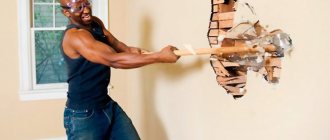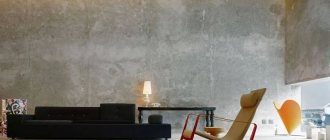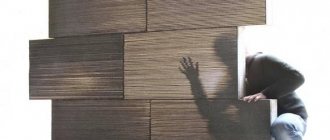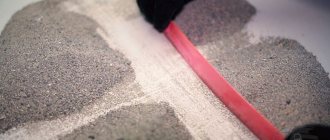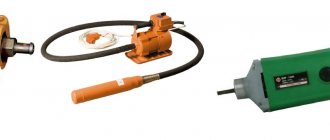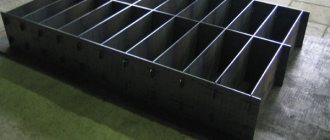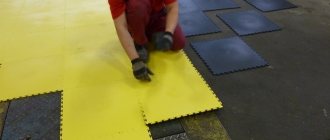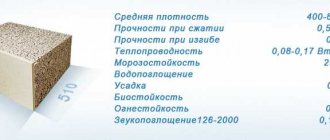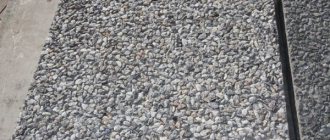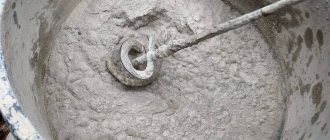The loft style interior is currently one of the most popular in the world. Residential and commercial premises are decorated with simple and multifunctional furniture, combining old stairs, unlined pipes with mirrors, and modern appliances. The result is a stylish interior for a relatively small amount of money.
A characteristic feature of the industrial style is the decoration of the walls with rough plaster, which imitates the rough texture of concrete. The advantage of a decorative coating for concrete is the ability to independently create a relief. It is worth remembering that in order to imitate concrete on a wall, you must choose high-quality materials and strictly adhere to the stages of their application.
What is decorative plaster for concrete?
Art plaster, or, in other words, art concrete, is a dry mixture that is diluted with water and turns into a thick mass. This is not real plaster, it is not used to level the walls, but is applied to the walls as a finishing decorative coating. As it hardens, it looks like a bare concrete surface: smooth, rough or bumpy, or even with any relief imprint.
RECOMMENDED ON THE TOPIC
- Concrete grade M300 - characteristics
- What is Art Concrete...
Previously, only offices, bars and other public places were decorated with concrete-like plaster. Now it is a common building material for the home, including even living rooms and bedrooms. Depending on the environment, it can look either spartan or very cozy.
And in the hallway, kitchen or bathroom, this is the most appropriate material for walls. You don’t have to worry that it will be “uncomfortable.” The plaster is also easy to clean and resistant to temperature changes.
It can be made warmer or cooler in tone by adding different pigments. You can not limit yourself to the gray-brown range, but choose a rich shade.
Note that decorative plaster is not the only way to decorate walls to look like concrete.
- An interesting effect is achieved by covering walls with tiles with a concrete texture (for example, in a bathroom) or panels. There is an expensive option - composite slabs made of porous concrete. There are decorative panels based on MDF or chipboard, finished with plaster or painted with concrete paint only on top. There are also lightweight gypsum panels.
- Concrete effect paint or liquid wallpaper. Many of them are afraid of dampness, so they are only suitable for living rooms. In addition, expressive relief cannot be achieved using this method; you can only imitate it with a pattern - dark and light spots.
- Concrete-effect photo wallpaper is the simplest and cleanest way, but not the cheapest. In addition, even the most realistic wallpaper is a flat picture: if you touch it with your hand, the illusion will dissipate. In general, for those who yearn for rich textures and natural materials, they are not suitable.
Next we will talk specifically about plaster solutions.
Panels
This type of finishing is quite simple and practical. Decorative panels for wall decoration can be selected from different materials (PVC, MDF, gypsum and gypsum vinyl, bamboo, cork, glass). Moreover, they are presented in a wide palette.
The panels are durable, very easy to care for, and if any part is damaged, they can be easily replaced. Moreover, they are easy to install and there is no need to carefully level the walls - the panels hide all imperfections.
One of the disadvantages is that they “steal” space due to the volume of the structure.
Elena Sedykh:
— Decorative panels are very versatile - they can be made soft or hard, and you can choose any design. But you need to remember: the more voluminous the decor, the more difficult it is to clean. In addition, the materials can be expensive.
Features and types of plaster
What is the difference between decorative concrete and ordinary plaster, which is used to level walls? They both contain cement, sand, and sometimes lime, but in the decorative mixture, in addition to them, polymers are required - to impart plasticity, color and other properties. The difference between them is not so great, the question is the ratio of the components and their quality, because you need the plaster not only to stick to the wall, but also to look good. The sand used for them is pure, quartz.
Decorative plasters differ in the filler fraction: the larger it is, the more prominent the surface will be. Conventionally, microcement is distinguished - with quartz sand (particles up to 1 mm), and microconcrete - with quartz chips (more than 1 mm).
